-
 Artist: Utagawa Kunisada [歌川 国貞] a.k.a. Utagawa Toyokuni III [三代歌川豊国] (Japanese, 1786 – 1865). Publisher: Nishimuraya Yohachi [西村屋与八] (Japanese, fl. c. 1751 – 1860), seal name: Eijudō. Date: c. 1821–22 (Bunsei 4–5) Size: Ōban tate-e triptych, each sheet 36.8 x 26.4 cm. Signed: 五渡亭国貞画 – Gototei Kunisada ga (on center sheet). Censor’s seal: kiwame 改印: 極 A view of the dressing room of a Theater in Dōtonbori, Ōsaka (Ōsaka Dōtonbori shibai gakuya no zu): Right sheet: Actors Bandō Mitsuemon I, Asao Tamejūrō III, Ichikawa Danzō V, Nakamura Utaemon III, Bandō Mitsugorō III (in a costume of Matsuômaru), Kiriyama Monji III, Nakamura Utashichi II, Arashi Shôroku IV, Nakamura Matsue III, Matsumoto Kōshirō V, Ichikawa Komazō V. Centre sheet: Arashi Mitsugorō III, Mimasu Daigorō III, Nakayama Bunshichi III, Ichikawa Ichizō II, Bandō Minosuke II, Ichikawa Omezō I, Arashi Kitsusaburō I, Nakamura Utaroku I, Kataoka Nizaemon VII, Ōtani Tomoemon III, Asao Yūjirō I. Left sheet: Asao Kuzaemon I, Arashi Hidenosuke III, Sawamura Gennosuke II, Iwai Ōginosuke, Sawamura Kunitarō II, Iwai Matsunosuke I, Ichikawa Sōzaburō IV, Iwai Hanshirō V (in a costume of Sakuramaru), and Ichikawa Shinzō III (L). The actors are making up for a performance of the “Carriage-Stopping” scene from Sugawara Denju Tenarai Kagami (Sugawara Denju and the Secrets of Calligraphy). References: MFA Accession №: 11.43384a-c; Catalogue Raisonné: Izzard, Kunisada’s World (1993), #34; Hizô Ukiyo-e taikan/Ukiyo-e Masterpieces in European Collections 5, Victoria and Albert Museum II (1987), pl. 22; Keyes, PMA Osaka cat. (1973), #250 and pl. 15 (The theatrical world of Osaka prints, by Roger S. Keyes and Keiko Mizushima, Philadelphia Museum of Art, 1973), pp. 70-71); Izzard, Kunisada's world revisited, 2021; V&A Accession № E.5995-1886. Kabuki actors on this print: Arashi Hidenosuke III [嵐秀之助] (Japanese, fl. 1794 – 1837); other names: Arashi Koshichi IV, Arashi Hinasuke IV, Arashi Sanjūrō VI, Kanō Hidenosuke II, Kanō Umetarō, Arashi Iwajirō III. Arashi Kitsusaburō I [嵐橘三郎] (Japanese, 1769 – 1821); other names: Arashi Kichisaburō II, Arashi Rikan I. Arashi Mitsugorō III (Japanese, ? – ?) Arashi Shōroku IV [四代目嵐小六] (Japanese, 1783 – 1826) Asao Kuzaemon I [浅尾工左衛門] (Japanese, 1758 – 1824); other names: Asai Kuzaemon Nakayama Tashirō II Takeda Nisaburō. Asao Tamejūrō III [三代目淺尾爲十郎] (Japanese, 1780 – 1836); other names: Asao Okuyama III, Asao Okuyama III, Asao Tomozō I. Asao Yūjirō I [浅尾勇次郎] (Japanese, 1782 – 1835); other names: Jitsukawa Gakujūrō I, Asao Gakujūrō, Nakamura Yaozō, Asao Yaozō. Bandō Minosuke II [坂東蓑助] (Japanese, 1802 – 1863); other names: Morita Kan'ya XI, Bandô Mitsugorō IV. Bandō Mitsuemon I [坂東三津右衛門] (Japanese, 1788 – 1846); other names: Bandō Kumahei [坂東熊平]. Bandō Mitsugorō III [三代目 坂東 三津五郎] (Japanese, 1775 – 1831); other names: Bandō Minosuke I, Morita Kanjirô II, Bandō Mitahachi I, Bandō Minosuke I, Bandō Mitahachi I. Ichikawa Danzō V [市川団蔵] (Japanese, 1788 – 1845); other names: Ichikawa Shikō I, Ichikawa Danzaburō IV, Ichikawa Danjirō I, Ichikawa Morinosuke I. Ichikawa Ichizō II [市川市蔵] (Japanese, 1806 – 1829); other names Ichikawa Ebijūrō II, Ichikawa Sukezō I. Ichikawa Komazō V [市川高麗蔵] (Japanese, 1812 – 1849); other names: Matsumoto Kinshō I, Matsumoto Kōshirō VI, Matsumoto Kinshi. Ichikawa Omezō I [市川男女蔵] (Japanese, 1781 – 1833); other names: Ichikawa Benzō II, Ichikawa Bennosuke. Ichikawa Shinzō III [市川新蔵] (Japanese, 1793 – 1837); other names: Ichikawa Sumizō III, Nakayama Tomisaburô II, Nakayama Kinsha, Nakayama Tomisaburō II, Ichikawa Komazō IV, Ichikawa Santarō. Ichikawa Sōzaburō IV (Japanese, ? – ?) Iwai Hanshirō V [岩井半四郎] (Japanese, 1776 – 1847); other names: Iwai Tojaku, Iwai Kumesaburō I. Iwai Matsunosuke I [岩井松之助] (Japanese, 1804 – 1845); other names: Iwai Hanshirō VII, Iwai Shijaku I, Iwai Komurasaki I. Iwai Ōginosuke (Japanese, ? – ?) Kataoka Nizaemon VII [七代目片岡仁左衛門] (Japanese, 1755 – 1837); other names: Yamazawa Kunigorō, Asao Kunigorō II, Nakamura Matsusuke. Kiriyama Monji III [桐山紋治] (Japanese, fl. c. 1803 – 1830); other names: Ichikawa Takigorō. Matsumoto Kōshirō V [五代目松本幸四郎] (Japanese, 1764-1838); other names: Ichikawa Komazô III, Ichikawa Sumizô I. Mimasu Daigorō III [三枡大五郎] (Japanese, 1782 – 1824); other names: Mimasu Seibē, Yoshizawa Kamezō. Nakamura Matsue III [三代目中村松江] (Japanese, 1786-1855); other names: Nakamura Sankō I, Nakamura Tomijūrō II, Ichikawa Kumatarō. Nakamura Utaemon III [中村歌右衛門] (Japanese, 1778 – 1838); other names: Nakamura Tamasuke, Nakamura Baigyoku I, Nakamura Shikan I, Kagaya Fukunosuke I. Nakamura Utaroku I (Japanese, ? – ?) Nakamura Utashichi II (Japanese, ? – ?) Nakayama Bunshichi III [三代目目中山文七] (Japanese, 1764 – 1853); other names: Nakayama Hyakka, Nakayama Hyōtarō I, Nakayama Tokusaburō. Ōtani Tomoemon III [大谷友右衛門] (Japanese, 1793–1839); other names: Arashi Shagan IV, Arashi Sanpachi II, Nakayama Monzaburō. Sawamura Gennosuke II [沢村源之助](Japanese, 1802/7 – 1853); other names: Suketakaya Takasuke III, Sawamura Chōjūrō V, Sawamura Sōjūrō V, Sawamura Tosshō I, Sawamura Genpei I. Sawamura Kunitarō II [沢村国太郎](Japanese, 1798 – 1836); other names: Ogino Kinshi, Ogino Yaegiri III, Ogino Kamekichi, Izumikawa Kamekichi.
Artist: Utagawa Kunisada [歌川 国貞] a.k.a. Utagawa Toyokuni III [三代歌川豊国] (Japanese, 1786 – 1865). Publisher: Nishimuraya Yohachi [西村屋与八] (Japanese, fl. c. 1751 – 1860), seal name: Eijudō. Date: c. 1821–22 (Bunsei 4–5) Size: Ōban tate-e triptych, each sheet 36.8 x 26.4 cm. Signed: 五渡亭国貞画 – Gototei Kunisada ga (on center sheet). Censor’s seal: kiwame 改印: 極 A view of the dressing room of a Theater in Dōtonbori, Ōsaka (Ōsaka Dōtonbori shibai gakuya no zu): Right sheet: Actors Bandō Mitsuemon I, Asao Tamejūrō III, Ichikawa Danzō V, Nakamura Utaemon III, Bandō Mitsugorō III (in a costume of Matsuômaru), Kiriyama Monji III, Nakamura Utashichi II, Arashi Shôroku IV, Nakamura Matsue III, Matsumoto Kōshirō V, Ichikawa Komazō V. Centre sheet: Arashi Mitsugorō III, Mimasu Daigorō III, Nakayama Bunshichi III, Ichikawa Ichizō II, Bandō Minosuke II, Ichikawa Omezō I, Arashi Kitsusaburō I, Nakamura Utaroku I, Kataoka Nizaemon VII, Ōtani Tomoemon III, Asao Yūjirō I. Left sheet: Asao Kuzaemon I, Arashi Hidenosuke III, Sawamura Gennosuke II, Iwai Ōginosuke, Sawamura Kunitarō II, Iwai Matsunosuke I, Ichikawa Sōzaburō IV, Iwai Hanshirō V (in a costume of Sakuramaru), and Ichikawa Shinzō III (L). The actors are making up for a performance of the “Carriage-Stopping” scene from Sugawara Denju Tenarai Kagami (Sugawara Denju and the Secrets of Calligraphy). References: MFA Accession №: 11.43384a-c; Catalogue Raisonné: Izzard, Kunisada’s World (1993), #34; Hizô Ukiyo-e taikan/Ukiyo-e Masterpieces in European Collections 5, Victoria and Albert Museum II (1987), pl. 22; Keyes, PMA Osaka cat. (1973), #250 and pl. 15 (The theatrical world of Osaka prints, by Roger S. Keyes and Keiko Mizushima, Philadelphia Museum of Art, 1973), pp. 70-71); Izzard, Kunisada's world revisited, 2021; V&A Accession № E.5995-1886. Kabuki actors on this print: Arashi Hidenosuke III [嵐秀之助] (Japanese, fl. 1794 – 1837); other names: Arashi Koshichi IV, Arashi Hinasuke IV, Arashi Sanjūrō VI, Kanō Hidenosuke II, Kanō Umetarō, Arashi Iwajirō III. Arashi Kitsusaburō I [嵐橘三郎] (Japanese, 1769 – 1821); other names: Arashi Kichisaburō II, Arashi Rikan I. Arashi Mitsugorō III (Japanese, ? – ?) Arashi Shōroku IV [四代目嵐小六] (Japanese, 1783 – 1826) Asao Kuzaemon I [浅尾工左衛門] (Japanese, 1758 – 1824); other names: Asai Kuzaemon Nakayama Tashirō II Takeda Nisaburō. Asao Tamejūrō III [三代目淺尾爲十郎] (Japanese, 1780 – 1836); other names: Asao Okuyama III, Asao Okuyama III, Asao Tomozō I. Asao Yūjirō I [浅尾勇次郎] (Japanese, 1782 – 1835); other names: Jitsukawa Gakujūrō I, Asao Gakujūrō, Nakamura Yaozō, Asao Yaozō. Bandō Minosuke II [坂東蓑助] (Japanese, 1802 – 1863); other names: Morita Kan'ya XI, Bandô Mitsugorō IV. Bandō Mitsuemon I [坂東三津右衛門] (Japanese, 1788 – 1846); other names: Bandō Kumahei [坂東熊平]. Bandō Mitsugorō III [三代目 坂東 三津五郎] (Japanese, 1775 – 1831); other names: Bandō Minosuke I, Morita Kanjirô II, Bandō Mitahachi I, Bandō Minosuke I, Bandō Mitahachi I. Ichikawa Danzō V [市川団蔵] (Japanese, 1788 – 1845); other names: Ichikawa Shikō I, Ichikawa Danzaburō IV, Ichikawa Danjirō I, Ichikawa Morinosuke I. Ichikawa Ichizō II [市川市蔵] (Japanese, 1806 – 1829); other names Ichikawa Ebijūrō II, Ichikawa Sukezō I. Ichikawa Komazō V [市川高麗蔵] (Japanese, 1812 – 1849); other names: Matsumoto Kinshō I, Matsumoto Kōshirō VI, Matsumoto Kinshi. Ichikawa Omezō I [市川男女蔵] (Japanese, 1781 – 1833); other names: Ichikawa Benzō II, Ichikawa Bennosuke. Ichikawa Shinzō III [市川新蔵] (Japanese, 1793 – 1837); other names: Ichikawa Sumizō III, Nakayama Tomisaburô II, Nakayama Kinsha, Nakayama Tomisaburō II, Ichikawa Komazō IV, Ichikawa Santarō. Ichikawa Sōzaburō IV (Japanese, ? – ?) Iwai Hanshirō V [岩井半四郎] (Japanese, 1776 – 1847); other names: Iwai Tojaku, Iwai Kumesaburō I. Iwai Matsunosuke I [岩井松之助] (Japanese, 1804 – 1845); other names: Iwai Hanshirō VII, Iwai Shijaku I, Iwai Komurasaki I. Iwai Ōginosuke (Japanese, ? – ?) Kataoka Nizaemon VII [七代目片岡仁左衛門] (Japanese, 1755 – 1837); other names: Yamazawa Kunigorō, Asao Kunigorō II, Nakamura Matsusuke. Kiriyama Monji III [桐山紋治] (Japanese, fl. c. 1803 – 1830); other names: Ichikawa Takigorō. Matsumoto Kōshirō V [五代目松本幸四郎] (Japanese, 1764-1838); other names: Ichikawa Komazô III, Ichikawa Sumizô I. Mimasu Daigorō III [三枡大五郎] (Japanese, 1782 – 1824); other names: Mimasu Seibē, Yoshizawa Kamezō. Nakamura Matsue III [三代目中村松江] (Japanese, 1786-1855); other names: Nakamura Sankō I, Nakamura Tomijūrō II, Ichikawa Kumatarō. Nakamura Utaemon III [中村歌右衛門] (Japanese, 1778 – 1838); other names: Nakamura Tamasuke, Nakamura Baigyoku I, Nakamura Shikan I, Kagaya Fukunosuke I. Nakamura Utaroku I (Japanese, ? – ?) Nakamura Utashichi II (Japanese, ? – ?) Nakayama Bunshichi III [三代目目中山文七] (Japanese, 1764 – 1853); other names: Nakayama Hyakka, Nakayama Hyōtarō I, Nakayama Tokusaburō. Ōtani Tomoemon III [大谷友右衛門] (Japanese, 1793–1839); other names: Arashi Shagan IV, Arashi Sanpachi II, Nakayama Monzaburō. Sawamura Gennosuke II [沢村源之助](Japanese, 1802/7 – 1853); other names: Suketakaya Takasuke III, Sawamura Chōjūrō V, Sawamura Sōjūrō V, Sawamura Tosshō I, Sawamura Genpei I. Sawamura Kunitarō II [沢村国太郎](Japanese, 1798 – 1836); other names: Ogino Kinshi, Ogino Yaegiri III, Ogino Kamekichi, Izumikawa Kamekichi. -
 Isoda Koryūsai (礒田 湖龍斎, 1735–1790), flourished: 1769 to 1790. The print lacks signature (signature erased).
Isoda Koryūsai (礒田 湖龍斎, 1735–1790), flourished: 1769 to 1790. The print lacks signature (signature erased).Attributed definitely to Koryūsai: Jacob Pins, #491 [p.202] - Saigyo Hoshi admiring Mount Fuji. Signature erased but convincingly attributed to Koryusai. Tikotin Museum, Haifa. Catalogue raisonné: Allen Hockley: A3-J-5 (p. 261).
Saigyō Hōshi (西行 法師, 1118 – March 23, 1190) was a famous Japanese poet of the late Heian and early Kamakura period. -
 Ichikawa Ebizo V (1791 – 1859) a.k.a. Ichikawa Danjûrô VII was a great-great-great-son of Ichikawa Danjûrô I. He started his stage career in 1794, at the age of 4, playing in Shibaraku (the role he is depicted here). During his stage life, he played every role type. He was later banished from Edo for living too luxurious life for an actor. While in exile he flourished in Kioto and Osaka. Kichirei (Festive Annual Custom). Publisher: Takenouchi Magohachi (Hoeidô) Circa 1833. Description: 役者の舞台姿を描いた「舞台姿」シリーズと、日常図を描いた「千社詣」シリーズがあり、同じ役者が向かい合って対になる。(『五渡亭国貞』). Signed: Gototei Kunisada ga [五渡亭国貞画]. Censor's seal: kiwame 改印:極. Ref.: Shindo, Gototei Kunisada Yakusha-e no Sekai (1993), plate 88; Utagawa Kunisada, 150th Anniversary of His Death, Ota Memorial Museum, no. 169; MFA ACCESSION NUMBER 11.43128.
Ichikawa Ebizo V (1791 – 1859) a.k.a. Ichikawa Danjûrô VII was a great-great-great-son of Ichikawa Danjûrô I. He started his stage career in 1794, at the age of 4, playing in Shibaraku (the role he is depicted here). During his stage life, he played every role type. He was later banished from Edo for living too luxurious life for an actor. While in exile he flourished in Kioto and Osaka. Kichirei (Festive Annual Custom). Publisher: Takenouchi Magohachi (Hoeidô) Circa 1833. Description: 役者の舞台姿を描いた「舞台姿」シリーズと、日常図を描いた「千社詣」シリーズがあり、同じ役者が向かい合って対になる。(『五渡亭国貞』). Signed: Gototei Kunisada ga [五渡亭国貞画]. Censor's seal: kiwame 改印:極. Ref.: Shindo, Gototei Kunisada Yakusha-e no Sekai (1993), plate 88; Utagawa Kunisada, 150th Anniversary of His Death, Ota Memorial Museum, no. 169; MFA ACCESSION NUMBER 11.43128. -
 Artist: Utagawa Kunisada [歌川 国貞] a.k.a. Utagawa Toyokuni III [三代歌川豊国] (Japanese, 1786 – 1865). Signed: Toyokuni ga [豊国 画] in a red toshidama cartouche. Publisher: Ibaya Senzaburō [伊場屋仙三郎] (Japanese, c. 1815 – 1869). Double nanushi censor seals: Hama & Magome, Kaei 2-5 (1849 – 1852). An uncut fan print (uchiwa-e, 220 x 292 mm) depicts a beautiful woman sitting on a balcony overlooking a bay and reading a book. Above the book, there is an obi with a pattern of stripes or modified key fret motif, with lettering that reads: 菅原島 [Sugawara-jima] and 美立 [mitate]. The lettering and the blossoming plum branch next to the obi provide an allusion to Sugawara no Michizane [菅原 道真/菅原 道眞] (Japanese, 845 – 903) - a prominent scholar and poet of Heian period exiled from Kyoto to the island of Kyushu as a result of another courtier's slander. A legend says that his beloved plum tree was so fond of its master that it flew to Kyushu with Sugawara. The Davis Museum at Wellesley College describes the print as belonging to the series A Parody of Sugawara Stripe Patterns (Mitate Sugawara-jima). To make the fact of an allusion transparent, Kunisada had changed the usual way of writing "Sugawara stripes" from 菅原縞 to 菅原島 and "mitate" from 見立 to 美立. An unusual spelling was also used to provide additional information to the reader in other cultures. E.g. during the Prohibition Era, the West Coast United States speakeasy bars and bordellos misspelt the items on a menu ("scollops") or in a neon sign ("Martuni's") to tell: here we have more pleasures for you than you may have expected. After Tenpō reforms, the printing of bijin-ga (美人画, "picture of beautiful woman") images was restricted. Our print disguises a typical bijin-ga as an advertisement of an obi (帯, a kimono sash) fabric pattern. "The market of portraits was satisfied and the authorities fooled" [Rebecca Salter. Japanese popular prints. — Honolulu: University of Hawaii Press, 2006].
Artist: Utagawa Kunisada [歌川 国貞] a.k.a. Utagawa Toyokuni III [三代歌川豊国] (Japanese, 1786 – 1865). Signed: Toyokuni ga [豊国 画] in a red toshidama cartouche. Publisher: Ibaya Senzaburō [伊場屋仙三郎] (Japanese, c. 1815 – 1869). Double nanushi censor seals: Hama & Magome, Kaei 2-5 (1849 – 1852). An uncut fan print (uchiwa-e, 220 x 292 mm) depicts a beautiful woman sitting on a balcony overlooking a bay and reading a book. Above the book, there is an obi with a pattern of stripes or modified key fret motif, with lettering that reads: 菅原島 [Sugawara-jima] and 美立 [mitate]. The lettering and the blossoming plum branch next to the obi provide an allusion to Sugawara no Michizane [菅原 道真/菅原 道眞] (Japanese, 845 – 903) - a prominent scholar and poet of Heian period exiled from Kyoto to the island of Kyushu as a result of another courtier's slander. A legend says that his beloved plum tree was so fond of its master that it flew to Kyushu with Sugawara. The Davis Museum at Wellesley College describes the print as belonging to the series A Parody of Sugawara Stripe Patterns (Mitate Sugawara-jima). To make the fact of an allusion transparent, Kunisada had changed the usual way of writing "Sugawara stripes" from 菅原縞 to 菅原島 and "mitate" from 見立 to 美立. An unusual spelling was also used to provide additional information to the reader in other cultures. E.g. during the Prohibition Era, the West Coast United States speakeasy bars and bordellos misspelt the items on a menu ("scollops") or in a neon sign ("Martuni's") to tell: here we have more pleasures for you than you may have expected. After Tenpō reforms, the printing of bijin-ga (美人画, "picture of beautiful woman") images was restricted. Our print disguises a typical bijin-ga as an advertisement of an obi (帯, a kimono sash) fabric pattern. "The market of portraits was satisfied and the authorities fooled" [Rebecca Salter. Japanese popular prints. — Honolulu: University of Hawaii Press, 2006]. -
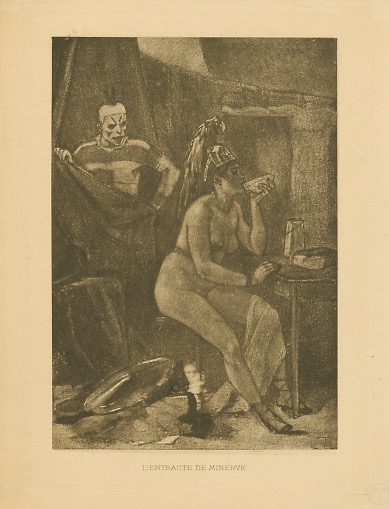
Photogravure after a pastel drawing by F. Rops. Monogrammed in the plate 'FR'. Owner's stamp 'LvM' on verso.
Dimensions: Paper: 26 x 20 cm; Plate: 25 x 18 cm; Image: 21 x 14.5 cm.
Catalogue raisonné: Arthur Hubschmid (1977): 543; Graphics irreverent and erotic (1968): 156.
-
 London: Published under the superintendence of the Society for the Diffusion of Useful Knowledge; Charles Knight & Co., no. 22 Ludgate Street. Dimensions: Sheet: 34 x 41.8 cm: Image: 28.7 x 38.3 cm. J. & C. Walker, Society for the Diffusion of Useful Knowledge Charles Knight & Co.; Charles Knight (British, 1791 – 1873) – publisher. J & C Walker (British firm, fl. 1820 – 1895) Walker, John (British, 1787 – 1873) Walker, Alexander (British, 1797? – 1870) Walker, Charles (British, 1799? – 1872) Society for the Diffusion of Useful Knowledge (SDUK) (British firm, 1826 – 1846)
London: Published under the superintendence of the Society for the Diffusion of Useful Knowledge; Charles Knight & Co., no. 22 Ludgate Street. Dimensions: Sheet: 34 x 41.8 cm: Image: 28.7 x 38.3 cm. J. & C. Walker, Society for the Diffusion of Useful Knowledge Charles Knight & Co.; Charles Knight (British, 1791 – 1873) – publisher. J & C Walker (British firm, fl. 1820 – 1895) Walker, John (British, 1787 – 1873) Walker, Alexander (British, 1797? – 1870) Walker, Charles (British, 1799? – 1872) Society for the Diffusion of Useful Knowledge (SDUK) (British firm, 1826 – 1846) -
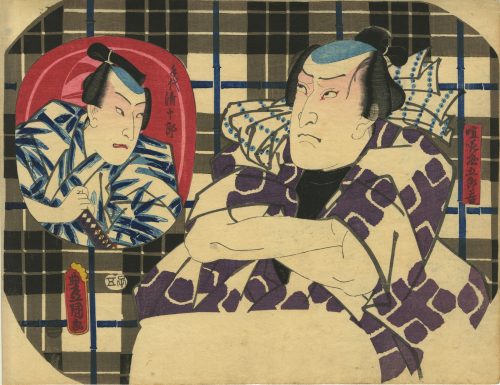 Artist: Utagawa Kunisada [歌川 国貞] a.k.a. Utagawa Toyokuni III [三代歌川豊国] (Japanese, 1786 – 1865). Publisher: Ibaya Senzaburō [伊場屋仙三郎] (Japanese, fl. C. 1845 – 1847). Date seal: [子五] Kaei 5, 5th month (5/1852). Signed: Toyokuni ga [豊国 画] in a red toshidama cartouche. Title: Actor Bandō Takesaburō I as clerk Seijūrō [手代清十郎] (left) and Actor Ichikawa Kodanji IV as Kenkaya Gorōkichi [喧嘩屋五郎吉] (right) in the play Musume ōgi tsui no tatehiki [娘扇一対侠贔屓 (むすめおうぎついのたてひき)] performed at the Nakamura theatre [中村座], in Edo (Tokyo). The playbill for this performance can be found at MFA (Boston) # 11.28042, 11.28285, 11.28286:
Artist: Utagawa Kunisada [歌川 国貞] a.k.a. Utagawa Toyokuni III [三代歌川豊国] (Japanese, 1786 – 1865). Publisher: Ibaya Senzaburō [伊場屋仙三郎] (Japanese, fl. C. 1845 – 1847). Date seal: [子五] Kaei 5, 5th month (5/1852). Signed: Toyokuni ga [豊国 画] in a red toshidama cartouche. Title: Actor Bandō Takesaburō I as clerk Seijūrō [手代清十郎] (left) and Actor Ichikawa Kodanji IV as Kenkaya Gorōkichi [喧嘩屋五郎吉] (right) in the play Musume ōgi tsui no tatehiki [娘扇一対侠贔屓 (むすめおうぎついのたてひき)] performed at the Nakamura theatre [中村座], in Edo (Tokyo). The playbill for this performance can be found at MFA (Boston) # 11.28042, 11.28285, 11.28286: Actors:
Bandō Takesaburō I (初代坂東竹三郎) (Japanese, 1832 – 1877); other names: Shinshi, Shinsui V, Bandō Hikosaburō V [五代目坂東彦三郎], Bandō Tsurunosuke I.
Ichikawa Kodanji IV [市川小團次] (Japanese, 1812 – 1866); other names: Ichikawa Yonejūrō I, Ichikawa Yonezō III, Ichikawa Eizō.
Actors:
Bandō Takesaburō I (初代坂東竹三郎) (Japanese, 1832 – 1877); other names: Shinshi, Shinsui V, Bandō Hikosaburō V [五代目坂東彦三郎], Bandō Tsurunosuke I.
Ichikawa Kodanji IV [市川小團次] (Japanese, 1812 – 1866); other names: Ichikawa Yonejūrō I, Ichikawa Yonezō III, Ichikawa Eizō.
Similar images were then used for the series Seven flourishing plants on lanterns for summer evenings [涼調珍盛の七草] (Suzumi chōchin sakari no nanakusa) published by Ibaya Senzaburō in 1852 (Kaei 5), 6th month.

Bandō Takesaburō I (carved by Yokokawa Takejirō): https://collections.mfa.org/objects/219360

Actor Ichikawa Kodanji IV (carved by Nakamura Tōkichi): https://collections.mfa.org/objects/477146.
-
 Artist: Utagawa Kunisada [歌川 国貞] a.k.a. Utagawa Toyokuni III [三代歌川豊国] (Japanese, 1786 – 1865). No publisher seal, no date or censor seal; probably a private printing. Signed: Kunisada ga [国貞画] in a red double gourd cartouche. Media: Untrimmed fan print (uchiwa-e), 231 x 294 mm, with the use of mica and black lacquer.
Artist: Utagawa Kunisada [歌川 国貞] a.k.a. Utagawa Toyokuni III [三代歌川豊国] (Japanese, 1786 – 1865). No publisher seal, no date or censor seal; probably a private printing. Signed: Kunisada ga [国貞画] in a red double gourd cartouche. Media: Untrimmed fan print (uchiwa-e), 231 x 294 mm, with the use of mica and black lacquer. -
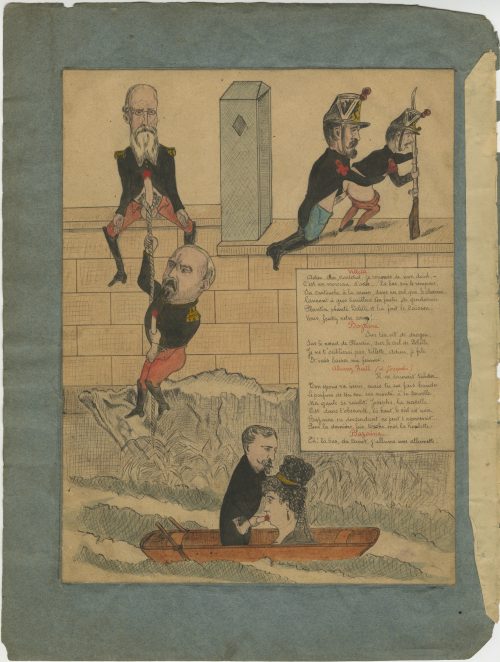 A series of seven political caricatures with indecent content, ink and pigment on paper, bound in a grey-blue folder. Each drawing is pasted to a grey-blue sheet of paper 32 x 24 cm. PLATES: 1) Villette; Bazaine; Alvarez Rull: 250 x 192 mm
A series of seven political caricatures with indecent content, ink and pigment on paper, bound in a grey-blue folder. Each drawing is pasted to a grey-blue sheet of paper 32 x 24 cm. PLATES: 1) Villette; Bazaine; Alvarez Rull: 250 x 192 mm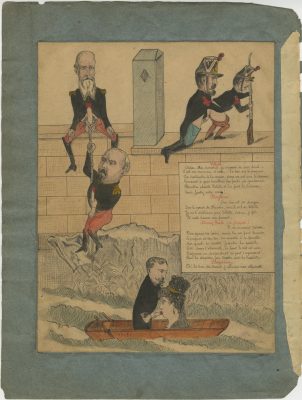
Villette Adieu, cher maréchal, je réponds de mon dard C’est un morceau d’acier… Là bas, sur le rempart, Sa cartouche à la main, dans un cul qui le charme, Lançant à gros bouillons son foutre de gendarme Plantin plante Delille et lui font le Caisson. Bazaine Sur ton vit de dragon Sur le nœud de Plantin, sur le cul de Delille, Je ne t’oublierai pas, Villette, adieu, je file Et je vais baiser ma femme. Alvarez Rull (à Josépha) Il ne saurait tarder, Ton epoux va venir, mais tu me fais bander, Le parfum de ton con me monte à la cervelle, Ma gaule se raidit . Josépha, la nacelle Est dans l’ obscurité, là haut, le ciel est noir, Bazaine en descendant ne peut t’ apercevoir … Pour la dernière fois, torche moi la houlette. Bazaine Eh ! là bas, du canot, j’allume une allumette!
Villette Farewell, dear Marshal, I vouch for my dick. It’s like a steel rod … Over there, on the ramparts, Plantin, his dick in hand, pounds Delisle’s beckoning ass And fills it with his bubbling gendarme’s cum. Bazaine For your dragoon’s dick, For Plantin's prick, for Delisle's ass, I won't forget you, Villette, goodbye, I'm leaving And I'm going to fuck my wife. Alvarez Rull (to Josépha) Hurry up, Your husband is coming, but I got a hard on you, The scent of your cunt penetrates my brain, My rod stiffened. Josépha, the gondola Is in the dark, the sky is black, Bazaine coming down and cannot see you... Give me one last blowjob.Bazaine Hey! Over there, from the canoe, I light a match!
French marshal Achille Bazaine capitulated to Bismarck during the Franco-Prussian war on 27 October 1870. In 1873, he was tried for treason and received a death sentence, later commuted to 20 years' imprisonment. Bazaine was incarcerated in the Fort Royal on Île Sainte-Marguerite, from which he escaped on August 9–10, 1874, with the help of Colonel Villette [Willette], his wife Josefa [Pepita Peña], and her nephew Alvarez Rull. They sailed to Genoa in Italy and from there to London. Plantin and Delisle were prison guards. The story was described in detail during the Trial of Col. Villette and his Accomplices in 1874 and published later in Robert Christophe. La Vie tragique du maréchal Bazaine. — Paris: Vautrain Jacques, 1947.
2) Impératrice Eugénie: 218 x 165 mm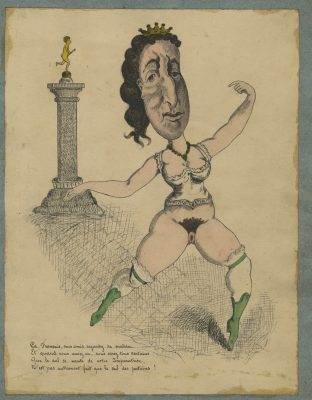
Ça, Français, mes amis, regardez sa matrice, Et quand vous aurez vu, vous serez tous certains Que le cul si vanté de votre Impératrice, N’est pas autrement fait que le cul des putains!
That, French, my friends, look at her cunt, And when you have seen, you will all be certain That the so acclaimed ass of your Empress, Is no different than the ass of whores! 3) Napoléon III: 215 x 168 mm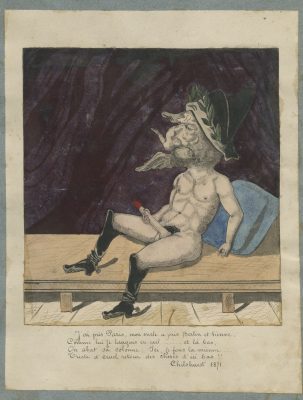
J’ai pris Paris, mon oncle a pris Berlin et Vienne. Comme lui je languis en exil …… et là bas, On abat sa colonne; Ici, je fous la mienne…. Triste et cruel retour des choses d’ici bas!! Chilshurst 1871. [i.e. Chislehurst]
I took Paris, my uncle took Berlin and Vienna. Like him, I, too, languish in exile. His column there was demolished; I’m jerking mine off here…. Cruel and sorrowful deeds!! 4) La confession: 216 x 168 mm (Georges Darboy?)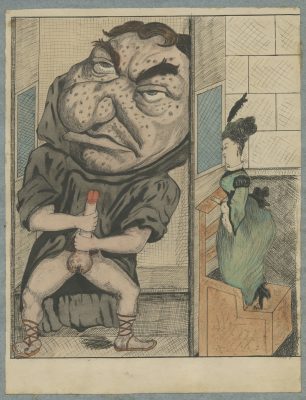 5) Napoléon III et Thérèsa (chanteuse Désirée Emma Valladon): 216 x 176 mm
5) Napoléon III et Thérèsa (chanteuse Désirée Emma Valladon): 216 x 176 mm
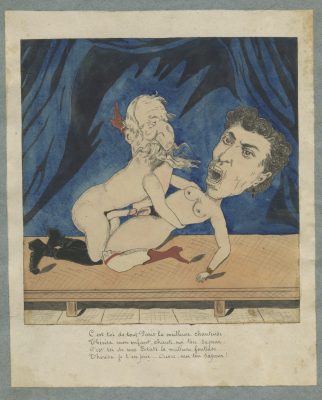
C’est toi de tout Paris la meilleure chanteuse, Thérèsa mon enfant, chante-moi ton sapeur. C’est toi de mes Etats la meilleure fonteuse.. Thérèsa je t’en prie … Ouvre-moi ton sapeur!
You, the best singer in all of Paris, Teresa, my child, sing for me where to insert. You are the best padding in my entire country… Teresa, please... Open your slit for me! 6) Thiers: 219 x 168 mm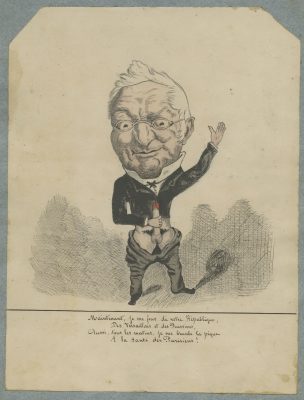
Maintenant, je me fous de votre République, Des Versaillais et des Prussiens, Aussi, tous les matins, je me branle la pique A la santé des Parisiens!
Yes, I don’t care about your Republic now, About Versailles and the Prussians, And every morning I jerk off For the health of Parisians! 7) Émile Ollivier/Rochefort/Jules Favre/Gambetta : 212 x 168 mm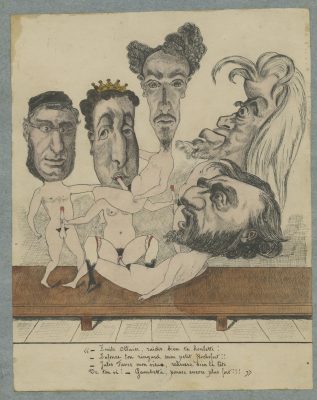
« — Emile Ollivier, raidis bien la houlette! — Enfonce ton ringard mon petit Rochefort!! — Jules Favre mon vieux, redresse bien la tête De ton vi! — Gambetta, pousse encore plus fort!!! »
Emile Ollivier, tighten your dick! - Stick in your poker, my little Rochefort!! - Jules Favre, old man, straighten your dickhead Damn it! – Gambetta, push even harder!!!Characters: Bazaine, François Achille (French, 1811 – 1888) Darboy, Georges (French, 1813 – 1871) Favre, Jules (French, 1809 – 1880) Gambetta, Léon (French, 1838 – 1882) Montijo, Eugénie de (Spanish-French, 1826 – 1920) Napoleon III [Bonaparte, Charles-Louis Napoléon] (French, 1808 – 1873) Ollivier, Émile (French, 1825 – 1913) Peña Azcárate, Josefa [Peña, Pepita] (Mexican-French, 1847 – 1900); Alvarez Rull – nephew of Josefa Peña Azcárate. Rochefort, Henri (French, 1831 – 1913) Thérésa [Valladon, Désirée Emma] (French, 1836 – 1913) Thiers, Adolphe (French, 1797 – 1877)
-
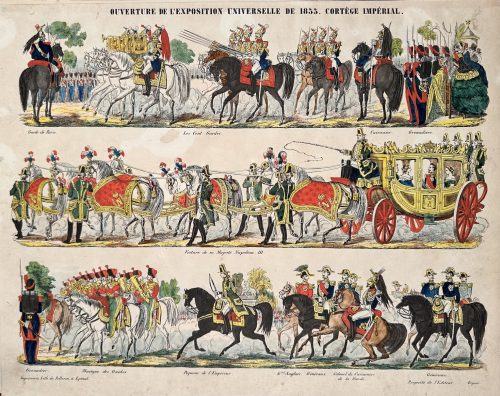 Hand-coloured woodcut on wove paper, 366 x 460 mm; black ink stamp “5057” to reverse. Caption cartoon in 2 tiers. Top: OUVERTURE DE 'EXPOSITION UNIVERSELLE DE 1855. CORTÈGE IMPÉRIAL. Captions top to bottom: Garde de Paris. — Les Cent Gardes. — Cuirassier. — Grenadiers. Middle: Voiture de sa Majesté Napoléon III. | Bottom: Grenadier. — Musique des Guides. — Piqueur de l’Empereur. — Gral Anglais — Généraux — Colonel de Cuirassiers | de la Garde — Généraux. Below left: Imprimerie Lith. de Pellerin, à Épinal; right: Propriété de l’Éditeur. Déposé. Jean Charles Pellerin (French, 1756 – 1836) – printer/publisher.
Hand-coloured woodcut on wove paper, 366 x 460 mm; black ink stamp “5057” to reverse. Caption cartoon in 2 tiers. Top: OUVERTURE DE 'EXPOSITION UNIVERSELLE DE 1855. CORTÈGE IMPÉRIAL. Captions top to bottom: Garde de Paris. — Les Cent Gardes. — Cuirassier. — Grenadiers. Middle: Voiture de sa Majesté Napoléon III. | Bottom: Grenadier. — Musique des Guides. — Piqueur de l’Empereur. — Gral Anglais — Généraux — Colonel de Cuirassiers | de la Garde — Généraux. Below left: Imprimerie Lith. de Pellerin, à Épinal; right: Propriété de l’Éditeur. Déposé. Jean Charles Pellerin (French, 1756 – 1836) – printer/publisher. -
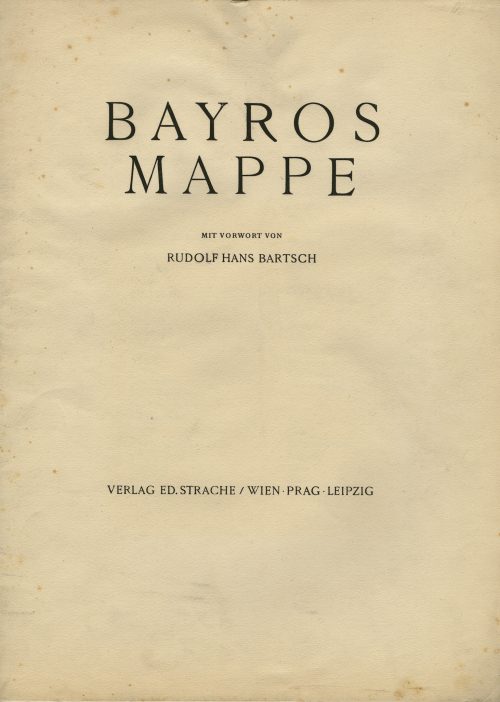 An album 45 of 50 prints, 31 photogravures and 14 in raster chromotype after drawings and paintings by Franz von Bayros; most with tissue guards, some in passepartout; colour prints mounted on the same paper that is used for photogravures. Title-page: BAYROS | MAPPE | MIT VORWORT VON | RUDOLF HANS BARTSCH | VERLAG ED. STRACHE / WIEN • PRAG • LEIPZIG || Limited edition of 500 copies. This is copy № 286. Lacking 5 prints: (1) Abschied vom Paradies, (2) Weihnacht, and (3) Harmonie from Symphonie von der Gūte, die Schönheit ist; (4) Divina commedia from Florentiner Phantasien; and (5) Mozart from Varia. Contributors: Franz von Bayros (Austrian, 1866 – 1924) Rudolf Hans Bartsch (Austrian, 1873 – 1952)
An album 45 of 50 prints, 31 photogravures and 14 in raster chromotype after drawings and paintings by Franz von Bayros; most with tissue guards, some in passepartout; colour prints mounted on the same paper that is used for photogravures. Title-page: BAYROS | MAPPE | MIT VORWORT VON | RUDOLF HANS BARTSCH | VERLAG ED. STRACHE / WIEN • PRAG • LEIPZIG || Limited edition of 500 copies. This is copy № 286. Lacking 5 prints: (1) Abschied vom Paradies, (2) Weihnacht, and (3) Harmonie from Symphonie von der Gūte, die Schönheit ist; (4) Divina commedia from Florentiner Phantasien; and (5) Mozart from Varia. Contributors: Franz von Bayros (Austrian, 1866 – 1924) Rudolf Hans Bartsch (Austrian, 1873 – 1952) -
 Artist: Utagawa Kunisada [歌川 国貞] a.k.a. Utagawa Toyokuni III [三代歌川豊国] (Japanese, 1786 – 1865). Signed: Ōju Toyokuni ga [応需豊国画], in a toshidama cartouche. Double nanushi censor seals: Mera & Murata (1846-50). Publisher: Kojimaya Jūbei [小嶋屋重兵衛] (Japanese, fl. c. 1797 – 1869). A beautiful woman, possibly a kabuki actor Iwai Hanshirō VIII [岩井半四郎] (Iwai Shijaku II, Iwai Kumesaburō III [岩井粂三郎], Iwai Hisajirō II, Japanese, 1829 – 1882), tuning the samisen on a veranda under the shining stars. The complete set of series Moon, Sun, Stars [月日星] (tsuki-hi-hoshi/boshi), three sources of light (sankō) [三光]:
Artist: Utagawa Kunisada [歌川 国貞] a.k.a. Utagawa Toyokuni III [三代歌川豊国] (Japanese, 1786 – 1865). Signed: Ōju Toyokuni ga [応需豊国画], in a toshidama cartouche. Double nanushi censor seals: Mera & Murata (1846-50). Publisher: Kojimaya Jūbei [小嶋屋重兵衛] (Japanese, fl. c. 1797 – 1869). A beautiful woman, possibly a kabuki actor Iwai Hanshirō VIII [岩井半四郎] (Iwai Shijaku II, Iwai Kumesaburō III [岩井粂三郎], Iwai Hisajirō II, Japanese, 1829 – 1882), tuning the samisen on a veranda under the shining stars. The complete set of series Moon, Sun, Stars [月日星] (tsuki-hi-hoshi/boshi), three sources of light (sankō) [三光]: -
 Kitagawa Utamaro. According to Chris Uhlenberg this is an illustration from the book Ehon koi no Onamaki, 3 vols, published in Kansei 11 (1799). Illustrated in b/w in: Hayashi Yoshikazu: Kitagawa Utamaro, in the series: Edo makura-e shi shusei, published in 1990, reissued 1994. Size: Chuban (25.5 x 18.5 cm), two book pages glued together.
Kitagawa Utamaro. According to Chris Uhlenberg this is an illustration from the book Ehon koi no Onamaki, 3 vols, published in Kansei 11 (1799). Illustrated in b/w in: Hayashi Yoshikazu: Kitagawa Utamaro, in the series: Edo makura-e shi shusei, published in 1990, reissued 1994. Size: Chuban (25.5 x 18.5 cm), two book pages glued together. -
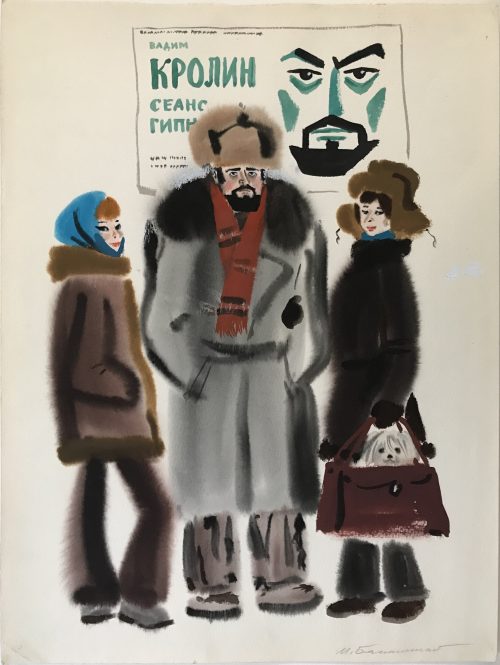 Mikhail Belomlinsky. Born 1934, Russia. Vadim Krolin, hypnosis session. Watercolor painting on paper from Chukotka expedition, ca. 1970s. Size: 36 x 48 cm.
Mikhail Belomlinsky. Born 1934, Russia. Vadim Krolin, hypnosis session. Watercolor painting on paper from Chukotka expedition, ca. 1970s. Size: 36 x 48 cm. -
 Title: Lyon Collection: Genji, Chapter 21, the maiden (otome - 乙女): the nine-tailed fox woman (kayō-fujin [花陽夫人]) terrorizing Prince Hanzoku (足王) and his servant from the series Japanese and Chinese parallels to Genji (wakan nazorae genji - 和漢准源氏). British Museum: Otome 乙女 (Maiden) / Waken nazorae Genji 和漢准源氏 (Japanese and Chinese Comparisons for the Chapters of the Genji). Schaap: Prince Hanzoku terrorized by a nine-tailed fox; Series: Wakan nazorae Genji (Japanese and Chinese parallels to Genji) Artist: Utagawa Kuniyoshi [歌川 國芳] (1798 – 1861). Publisher: Iseyoshi [伊勢芳] (Marks 25-013 | U095); seal [イせ芳]. Block carver: Hori Shōji [彫庄治] (Lyon Collection; BM); Hori Takichi [彫多吉] (Schaap). Date-aratame seal: Ansei 2, 7th month (1855). Ref: Jack Hillier. Japanese prints and drawings from the Vever Collection (3 volumes). — New York: Sotheby Parke Bernet & Rizzoli International, 1976; vol.3, p. 868, pl. 847. Robinson (1982): p. 161, S88, № 21. Schaap (1998): p. 115, № 107. SOLD
Title: Lyon Collection: Genji, Chapter 21, the maiden (otome - 乙女): the nine-tailed fox woman (kayō-fujin [花陽夫人]) terrorizing Prince Hanzoku (足王) and his servant from the series Japanese and Chinese parallels to Genji (wakan nazorae genji - 和漢准源氏). British Museum: Otome 乙女 (Maiden) / Waken nazorae Genji 和漢准源氏 (Japanese and Chinese Comparisons for the Chapters of the Genji). Schaap: Prince Hanzoku terrorized by a nine-tailed fox; Series: Wakan nazorae Genji (Japanese and Chinese parallels to Genji) Artist: Utagawa Kuniyoshi [歌川 國芳] (1798 – 1861). Publisher: Iseyoshi [伊勢芳] (Marks 25-013 | U095); seal [イせ芳]. Block carver: Hori Shōji [彫庄治] (Lyon Collection; BM); Hori Takichi [彫多吉] (Schaap). Date-aratame seal: Ansei 2, 7th month (1855). Ref: Jack Hillier. Japanese prints and drawings from the Vever Collection (3 volumes). — New York: Sotheby Parke Bernet & Rizzoli International, 1976; vol.3, p. 868, pl. 847. Robinson (1982): p. 161, S88, № 21. Schaap (1998): p. 115, № 107. SOLD -
 Artist: Utagawa Kunisada [歌川 国貞], a.k.a. Utagawa Toyokuni III [三代 歌川 豊国] (Japanese, 1786 – 1865). Signed: Toyokuni ga [豊国 画] in a red toshidama cartouche Block carver: Yokokawa Takejirō [横川竹二郎] (Japanese, fl. 1845 – 1863); seal: Hori Take [彫竹]. Publisher: Iseya Magobei [伊勢屋孫兵衛] (Japanese, fl. c. 1794 – 1868); seal: Hanmoto, Masu [板元, 益] (Marks 19-039 | 150d). Date-aratame seal: Ansei 2 (1855). Title: Time in Fukagawa, Iyo Province (Fukagawa Iyo setsu). Ref.: [LIB-3008.2022] Andreas Marks. Japanese woodblock prints: Artists, publishers and masterworks, 1680 – 1900. — Tuttle Publishing, 2010; p. 221. –> 1855 Kunisada. "Iyo Province-time at Fukagawa" (Fukagawa Iyo setsu). Fan print. Japan Ukiyo-e Museum, Matsumoto.
Artist: Utagawa Kunisada [歌川 国貞], a.k.a. Utagawa Toyokuni III [三代 歌川 豊国] (Japanese, 1786 – 1865). Signed: Toyokuni ga [豊国 画] in a red toshidama cartouche Block carver: Yokokawa Takejirō [横川竹二郎] (Japanese, fl. 1845 – 1863); seal: Hori Take [彫竹]. Publisher: Iseya Magobei [伊勢屋孫兵衛] (Japanese, fl. c. 1794 – 1868); seal: Hanmoto, Masu [板元, 益] (Marks 19-039 | 150d). Date-aratame seal: Ansei 2 (1855). Title: Time in Fukagawa, Iyo Province (Fukagawa Iyo setsu). Ref.: [LIB-3008.2022] Andreas Marks. Japanese woodblock prints: Artists, publishers and masterworks, 1680 – 1900. — Tuttle Publishing, 2010; p. 221. –> 1855 Kunisada. "Iyo Province-time at Fukagawa" (Fukagawa Iyo setsu). Fan print. Japan Ukiyo-e Museum, Matsumoto. -
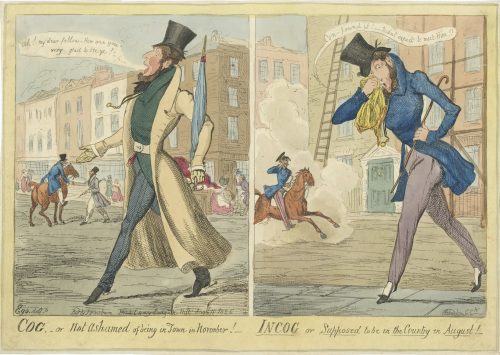 Description by British Museum (1865,1111.2128): "Two designs, side by side. [1] A dandy (probably a portrait), florid, whiskered, and bearded, steps jauntily from the pavement, hand extended, saying: Ah! my dear fellow — How are you? Devilish glad to see ye!— He holds a closed umbrella, ferrule erect, and wears a long tight-waisted coat to the heels, unbuttoned, tight pantaloons and spurred boots. In the middle distance, another dandy grasps the hand of a friend on horseback. Behind are houses with shop-fronts. A man raises his hat to a lady who curtseys. [2] The same dandy steps from the roadway onto the pavement, his handkerchief to his nose; he stoops, trying to conceal himself from a dandy cantering past in a cloud of dust, his eye-glass to his eye. He is without gloves, extraordinary for a dandy, and his trousers are strapped over pumps; he says: Con-found it! — Didn't expect to meet Him!! The street is otherwise empty; against the (large) houses are scaffolding and a tall ladder." Lettered with title, text within image including production details: 'Ego. delt / Etched by G. Ck / Pubd by J Fairburn Broadway Ludgate Hill August 18 1826'. Dimensions: Sheet: 25.5 x 36 cm, Image: 21.7 x 33.8 cm. Catalogue raisonné: A. M. Cohn (1924): № 1001, p. 262.: "A wretched plate. Difficult to believe G. C. had anything to do with it." — Bruton. Value.— £1.
Description by British Museum (1865,1111.2128): "Two designs, side by side. [1] A dandy (probably a portrait), florid, whiskered, and bearded, steps jauntily from the pavement, hand extended, saying: Ah! my dear fellow — How are you? Devilish glad to see ye!— He holds a closed umbrella, ferrule erect, and wears a long tight-waisted coat to the heels, unbuttoned, tight pantaloons and spurred boots. In the middle distance, another dandy grasps the hand of a friend on horseback. Behind are houses with shop-fronts. A man raises his hat to a lady who curtseys. [2] The same dandy steps from the roadway onto the pavement, his handkerchief to his nose; he stoops, trying to conceal himself from a dandy cantering past in a cloud of dust, his eye-glass to his eye. He is without gloves, extraordinary for a dandy, and his trousers are strapped over pumps; he says: Con-found it! — Didn't expect to meet Him!! The street is otherwise empty; against the (large) houses are scaffolding and a tall ladder." Lettered with title, text within image including production details: 'Ego. delt / Etched by G. Ck / Pubd by J Fairburn Broadway Ludgate Hill August 18 1826'. Dimensions: Sheet: 25.5 x 36 cm, Image: 21.7 x 33.8 cm. Catalogue raisonné: A. M. Cohn (1924): № 1001, p. 262.: "A wretched plate. Difficult to believe G. C. had anything to do with it." — Bruton. Value.— £1. -
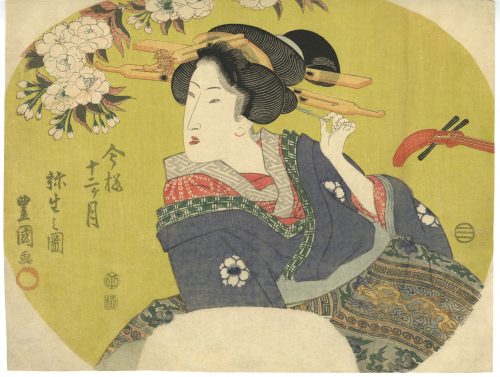 Title: Third lunar month [弥生] (Yayoi no zu); Series: Fashionable Twelve Months (Imayo juni-kagetsu). Another version of translation: Modern Beauties of Twelve Months. Artist: Utagawa Toyokuni I [歌川豊国] (1769–1825). Pubisher: Ibaya Senzaburō [伊場屋仙三郎] (Japanese, 1815 – 1869), seal: Dansendō [伊場仙]. Signed: Toyokuni ga and sealed with toshidama. Date-kiwame seal: Ushi (ox), Bunsei 5 (1822). Size: double-sheet uncut fan print ( aiban uchiwa-e), 219 x 295 mm.
Title: Third lunar month [弥生] (Yayoi no zu); Series: Fashionable Twelve Months (Imayo juni-kagetsu). Another version of translation: Modern Beauties of Twelve Months. Artist: Utagawa Toyokuni I [歌川豊国] (1769–1825). Pubisher: Ibaya Senzaburō [伊場屋仙三郎] (Japanese, 1815 – 1869), seal: Dansendō [伊場仙]. Signed: Toyokuni ga and sealed with toshidama. Date-kiwame seal: Ushi (ox), Bunsei 5 (1822). Size: double-sheet uncut fan print ( aiban uchiwa-e), 219 x 295 mm.






